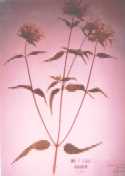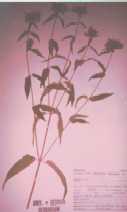
Photo by Ben Turnage
specimen of UGA Herbarium
Collected by G. Dorsey
in DeKalb Co., Ga.
July 1954
Identification
of Monarda fistulosa

Photo by Ben Turnage
specimen of UGA Herbarium
Collected by Harriet DiGioia
in Whitfield Co., Ga.
June 1976
Click on any image to zoom in

Though a holotype of the species could not be located, published descriptions yield the following:
Gray (1886) describes those species in the family Labiatae (Lamiaceae) as being dicots
having an "ovary deeply four-lobed around the style," the ovule erect, square stems, and opposite simple leaves with no stipules.
Each carpel of the pistil is 2-parted or 2-lobed, and stamens eminate on the tube of the carolla. It is from this tubular shape of
the carolla which the plant got its name, fistulosa meaning "tubular" in Latin. Those plants are commonly aromatic herbs
or undershrubs.
The fistulosa is an erect, aromatic, perennial herb, with a soft, mostly fuzzy stem. The plant generally grows to 3 to 4 feet high,
though sometimes reaching as much as 5 feet. The stem, for the most part, has few branches, all with light fuzz primarily occurring at the
joints of branches.
The leaves are narrow and gray-green, a good bit lighter and narrower than other related species, such as the M. didyma
and M. mollis. Leaves are petioled, acuted, smooth to hispid, and 1" to 3" long. Leaves are small-toothed, with tinges of pint to lavender on
upper leaves, another distinguishing characteristic (other species have tinges of a deeper red or purple, or no other coloration at all). Growing in pairs,
each on the opposite side of the stem, the leaves are lance to ovate-shaped, and carry a strong, minty smell. It is from this smell, which is very similar
to the Bergamot Orange in Virginia, that the plant gets its name. Both the leaves and flowers contain glands that secrete aromatic oils that have had many purposes
throughout the years (see the plant's history).
Identification by the flower clusters is the most obvious method, though even this can be tricky, according to which authority is being used. Gray (1886)
considers the M. mollis, media, and rubra varieties to be subspecies of the fistulosa, where most other authorities declare them separate species. To distinguish, however
they are classified, the M. rubra is very similar to the M. didyma, having bright crimson or rose-red carollas; the M. media generally has a deep purple bloom;
the M. mollis carolla is flesh color to lilac, with the upper lip hairy, leaves paler, and shorter petioles to the leaves. Blooms of the M. fistulosa occur from ealy July
to early September generally (though collected Georgia specimens in the University of Georgia Herbarium tended to have bloomed in early June). Flowers grow in dense terminal clusters
of 20-50 white to pink or purplish color, blooms generally 1 inch in total diameter. Blooms are generally 1 to 1.5 inches long. Each bloom is 2-lipped -- the upper one narrow and arched,
the lower 3-parted with a larger middle lobe. The upper lip of the carolla is hairy. Flower clusters occur at the summit of the stem or branch. Each cluster is surrounded by pinted bracts,
often tinged with lavender or pink.
Like other mints, the fistulosa spreads quickly and fairly agressively by creeping rhizomes, or runners, just under the surface of the ground. Since they are attached by the runners,
fistulosa plants usually occur in patches. Being perennial, the invasive nature of the species can cause it to choke out other smaller vegetation in more sensitive environments.
For more information on this, see the plant's ecological requirements.
The first description of the M. fistulosa came from physician for King Philip II of Spain, Dr. Nicolas Monardes, while exploring
the east coast of the New World (see the species' history). The plant was first classified by Carl von Linne (Linnaeus)
in his Species Plantarum of 1753.
Back to Monarda fistulosa page.